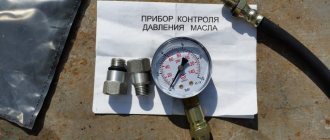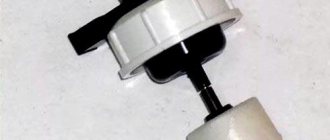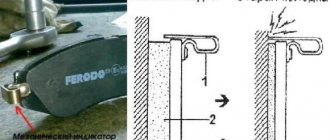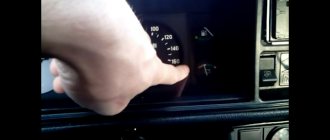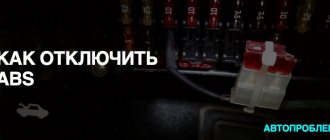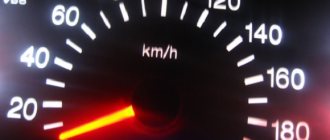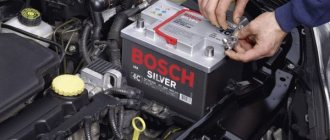A modern car is equipped with a large number of auxiliary electronic systems that increase driving safety. Some solutions improve directional stability, others affect braking efficiency, etc.
Drivers are familiar with these systems by their abbreviated names: ABS, ESP, EBD, etc. At the same time, one of the first systems to appear on cars was the ABS system, the main task of which was to prevent complete wheel locking during braking.
Moreover, in some countries it is prohibited by law to operate cars without ABS on public roads. Of course, if this system fails, the behavior of the car when braking changes greatly, and not for the better. The ABS icon also lights up on the dashboard, indicating that the problem needs to be repaired.
System Features
ABS consists of two parts - electronic and mechanical. The “weak” link in it is the electronics. It is sensitive, so even the slightest negative influences lead to interruptions in operation.
In a car equipped with ABS, there is a warning mechanism that signals the cessation of operation. And he does this by means of a warning light on the dashboard.
When the ignition is turned on, this lamp lights up as self-diagnosis occurs. The system checks its performance, and if no violations are noticed, the lamp goes out, indicating that the ABS is in working condition.
But drivers are faced with the fact that the ABS warning light comes on while driving, and this can only happen under certain conditions. For some, the signal may not go out at all, for others the lamp lights up only when a certain speed is reached. The warning light that comes on confuses the owners, and the reason for this is simple - ABS works with the brakes and they perceive a malfunction of the system as problems with the braking system, which is wrong.
ABS is an addition to a car's braking system that increases its efficiency. Therefore, even if the ABS malfunctions, the car remains able to brake, but you need to get used to the operation of the brakes.
The anti-lock braking system is designed in such a way that if a malfunction is detected, it immediately turns off completely so as not to have any effect on the operation of the brakes.
Car enthusiasts solve an ABS problem by removing the fuse responsible for the operation of the system and postponing troubleshooting until a suitable occasion. But this will not work if the car is equipped with a number of security systems and some of them are based on ABS. In this case, it will not be possible to continue driving, since the electronics will block the operation of a number of components and systems due to a malfunction. It is better not to delay eliminating the cause of the anti-lock braking system malfunction.
ABS function
The anti-lock braking system prevents the vehicle's wheels from locking when braking. The main purpose of the system is to ensure optimal braking efficiency (minimum braking distance) while maintaining vehicle stability and controllability. However, when braking on a road with uneven or loose surfaces (gravel, sand, unpacked snow), a slight increase in braking distance may occur compared to braking under the same conditions with locked wheels.
Braking, controlled by ABS, begins at speeds above 5–8 km/h and is accompanied by slight pulsation of the brake pedal and characteristic noise of the actuators. ABS stops regulating when the vehicle speed drops to 3–5 km/h.
When braking in an emergency, press the brake pedal as quickly and as hard as possible and do not release it until the end of braking. When changing direction while braking, do not release the brake pedal.
Warning ! Intermittent braking (releasing and pressing the brake pedal again) with ABS working will increase the braking distance.
The ABS status is indicated by the “ABS” indicator. The indicator lights up yellow when the ignition is turned on and goes out after the engine starts (self-test mode).
ATTENTION ! In all other cases, when the warning light comes on, this indicates an ABS malfunction, which must only be repaired by dealers.
If an ABS malfunction occurs, the operation of the hydraulic brake drive is not disrupted, and braking remains possible as on a car without ABS.
Why did the ABC light come on?
Video: The ABS light is on on the instrument panel. The brake lights do not go off.
As already noted, breakdowns occur in the electronic component, which includes sensors installed on the wheel hubs and the control unit. The mechanical component does not cause problems.
The “culprits” for the ABS warning light coming on:
- fuse;
- wheel speed detection sensors;
- setting elements of sensors;
- wiring;
- Control block.
Why the ABS fails can be easily identified by checking the listed components if the car is equipped with an on-board computer with a display on which error codes are displayed. This will significantly narrow down your search, since you can find out from the code which sensor is acting up.
In a car without an on-board computer display, to determine the malfunction, you will have to look for a scanner and connect it to the diagnostic connector to determine what caused the failure.
Note that identifying the error code will make the search easier, since diagnostics will not provide accurate information; it will indicate where to look for the fault. Therefore, you can even do without scanning.
Purpose of the ABS sensor and operating principle
The ABS sensor is one of the three main components of the system, which also includes the control module and hydraulic unit. The device determines the moment of wheel locking based on its rotation frequency. When this undesirable event occurs, the electronic control module receives the sensor signal and forms an effect on the hydraulic unit installed in the line immediately behind the main brake cylinder.
ABS sensor with wire and connector
The block reduces or even stops the supply of brake fluid to the locked wheel cylinder. If this is not enough, the solenoid valve will direct the fluid into the outlet line, relieving the pressure already in the master cylinder. When wheel rotation is restored, the control module removes the pressure from the valves, after which the hydraulic line pressure is transferred to the wheel brake cylinders.
Each wheel of the car is equipped with an ABS sensor.
Looking for a reason
You should start troubleshooting with the fuse. If this element burns out, the ABS does not work. Note that you should not always go into the fuse box, since the behavior of the system itself can give a “hint” regarding the serviceability of the fuse. For example, if the ABS light on the instrument panel comes on only under certain conditions, but after turning off the power to the ignition switch and restarting the engine, the problem disappears, then the problem is clearly not in the fuse. It should only be checked if the warning light is constantly on.
The sensors are located in a place that cannot be called well protected. Therefore, dirt sticking to it will easily cause a malfunction, causing the system to shut down.
Sensors may simply break during the process of repairing and servicing the chassis. Careless work and the use of impact tools during disassembly often cause internal damage to the sensors. Since they cannot be repaired, the damaged element will have to be replaced to restore ABS functionality.
What does the exclamation mark mean?
In the vast majority of cars, the "exclamation mark" icon on the instrument panel indicates problems with the car's braking system. Often it lights up in conjunction with an icon indicating the operation of the ABS system and the vehicle stabilization system (if equipped). The appearance of these icons on the driver's instrument panel means that there may be a problem with the brake system and the brakes cannot be trusted.
If the icon lights up immediately after starting the engine, it is better for the driver to postpone the trip and check the car’s braking system. If the icon lights up while driving, the driver needs to urgently stop and check the brake system.
Why does the ABS light even come on?
In a normally running vehicle, this indicator shows you that the wheels have been unlocked. In this case, everything works fine, the sensors sensed the need to turn on the safety system, initiated its operation and demonstrated to the driver that some assistance was provided when braking. When you see the ABS light on while braking, it is better to release the brake pedal a little and take over control of the car. If you have an expensive, high-tech car, you can trust the well-thought-out systems and let ABS+EBD do the job. In other cases, the light may be on for the following reasons:
- the sensors are clogged, the on-board computer indicates that the diagnostic error code should be read;
- Dirt or rust got on the sensors, which caused the anti-lock braking system to turn on incorrectly;
- there is a problem in the on-board electrical system, which is demonstrated by random lights coming on;
- the wheel bearing has failed, which forces the sensors to constantly turn on the anti-lock braking system by mistake;
- the fuses in the unit responsible for the ABS system have failed and are passing the signal directly;
- There was an error in the computer that caused the ABS light to come on.
Also, sometimes troubles occur with the generator and other elements of the machine’s electrical circuit, which can result in the lighting of the diagnostic system light or warning lights of any type. For example, on a Volkswagen car produced in the 2000s, the anti-lock braking system light comes on even if there is an error in completely different components. Therefore, self-diagnosis is only a partially acceptable method of solving the problem, because often the driver does not have special tools at hand for a good investigation.
ABS Lada Vesta error codes and their interpretation
Diagnosing ABS yourself is a rather difficult task if you do not have diagnostic equipment (cable, laptop, and software). If you have the ability to read errors, then by comparing their codes with the description, you can much faster determine the cause of the malfunction. The following are the errors that “light up” the anti-lock braking system malfunction light:
Thanks for subscribing!
- U0121 - no data from the ABS system controller
- U0122 - no data from ESP system controller
- U0415 - incorrect data from the ABS system controller
- U0416 - Invalid data from the ESP system controller
In most cases, the absence of data from the controller indicates a malfunction. If the diagnostics indicate errors U0415 or U0416, then there is a high probability of sensor malfunction or damaged wires. Also, do not forget that with different tire pressures, the control system may receive incorrect data from the controller and indicate the last two errors.
What can you check yourself if the ABS light comes on?
The first thing you can do on your own in such a situation is to go to a car wash and ask for a good wash of the rims. Often, this intensive pressure washing can clean the ABS sensors located near the brake discs. On your way to the car wash, you can perform another simple test. Accelerate to a speed of 80-90 kilometers per hour, close the windows and turn off the music. If in this driving mode you hear a slight or annoying hum in the area of the wheels (front or rear), the likely cause of the light is a failure of the wheel bearing. There are several other things you can do:
- inspect the fuse box and replace the module that is responsible for the operation of the anti-lock braking system;
- if possible, read the diagnostic error code and read about it on the forums;
- to a specialist, describing your situation, and then try to correct the error yourself;
- get to the ABS sensors yourself by jacking up the car and removing the wheels to check their cleanliness;
- inspect the electronic control unit located under the hood, check that there is no liquid in it or on it;
- the best solution is to go to a service station and pay for diagnostics of the car's anti-lock braking and electrical systems.
ABS turns on randomly, the light blinks or lights up periodically
One of the most difficult forms of breakdowns is the constant blinking of the ABS light. This means that the anti-lock braking system sensors send incorrect signals to the computer, which, in turn, issues other incorrect commands to the vehicle's systems and modules. In such cases, many people prefer to simply turn off the anti-lock system, since unpleasant incidents may occur. For example, turning on ABS at a speed of 90 kilometers per hour with light braking can damage the chassis of the car and contribute to a complete loss of control over control. It's better to do this:
- bring the car to a service center for diagnostics, find out the reason for the chaotic operation of the equipment;
- for domestic cars equipped with a primitive anti-blocking device, it is better to immediately disable the system;
- complex designs and on-board electronic systems of foreign cars will have to be reflashed for repair;
- on some machines it will be easier to find the problem and fix it than to disable the anti-lock;
- you need to keep in mind that this particular system is not always the cause of the ABS light coming on; the problems can be different;
- During the diagnostic process, it is better to check the entire on-board electrical system and equipment.
By paying a certain amount for a car inspection, you can get the right answers to important questions. Sometimes a light that comes on on the panel can develop into a full-fledged repair of important units and components of the car, so you will have to spend a lot. But in most cases, this problem is not so expensive to solve. The cost of repair work depends, of course, on the make and model of the car, and on the price of spare parts. If an ABS sensor for a domestic car costs from 600 rubles, then a Japanese SUV will cost more than 10,000 rubles to replace one such sensor. We suggest watching a video about solving a similar problem using computer diagnostics:
Let's sum it up
Problems with ABS are not very pleasant incidents in any case. It is better to stay away from various problems and try to operate the car according to the requirements and advice of the manufacturer. But sometimes this turns out to be impossible, so it is necessary to have a good service in mind that can help in different situations. By contacting an official service center with this problem, you may become a victim of an overly scrupulous approach to diagnostics and incur huge repair costs.
However, sometimes the problem with the ABS sensor and the light on this system can be solved independently. Use the tips described above in the publication to understand all the features of a particular troubleshooting method. We warn you that it is impossible to completely disable ABS yourself. The on-board computer will either simply not allow the car to start, or will begin to behave inappropriately, producing new diagnostic system error codes each time. Have you encountered incorrect operation of ABS sensors and a constantly burning light?
The ABS system is an important element of the entire car design, without which safe movement is indispensable. According to statistics, the reason for a large number of road accidents is that drivers do not use the braking system correctly. In most cases, this problem occurs in winter, when the road surface is very slippery. Let's take a closer look at the components of the ABS system, and also give advice on what to do if the ABS light comes on.
What is ABS?
The main function of ABS is to control the braking force of each wheel. However, this happens in such a way that the wheels of the car do not lock when braking, but the car quickly stops. Thanks to the ABS system, the driver does not lose control of the car during sudden braking.
If the anti-lock braking system is missing or faulty, then when braking hard, the wheels stop rotating or the wheels lock. For this reason, the car may skid, especially when sudden braking occurs when turning.
In any case, if the ABS light comes on, the anti-lock system does not work. It is easy to check whether there is a problem with ABS: you need to accelerate the car to 40 km/h and sharply press the brake pedal to the floor. If the vibration of the pedal is not felt, the ABS is not working. The anti-lock braking system allows you to press the brakes sharply and quickly go around an obstacle. Without ABS, it will not be possible to sharply press the brakes and at the same time go around an obstacle, because the car may simply skid.
Anti-lock brake system (ABS) device
When braking, ABS regulates fluid pressure in the working cylinders, preventing the wheels from completely locking. Thanks to this, the braking distance is reduced and the driver continues to control the vehicle’s trajectory even during intense braking on snow, sand or wet asphalt.
The principle of operation of the abs system. Video:
The anti-lock braking system includes the following parts:
- Control block. Electronics that change pressure by opening and closing bypass valves. It analyzes information about wheel rotation. When the wheel stops, the valve partially relieves pressure and the pad presses less.
- Sensors that control rotation speed. The devices are mounted on wheel hubs and operate due to the Hall effect. They transmit information to the ECU.
- Hydraulic block. It consists of hydraulic accumulators, solenoid valves for inlet and outlet, an electrically driven pump and damping chambers.
In their normal position, the exhaust valves are closed and prevent fluid from leaving the cylinder. Accordingly, the intakes are open and do not prevent pressure from increasing when the pedal is pressed. When the car brakes, fluid enters the cylinder, increasing the pressure in it. If the wheel starts to slow down too sharply, the ECU closes the intake valve, preventing blocking. If necessary, a signal is sent to open the release valve, which reduces the pressure to a value at which the wheel is unlocked.
Why does the indicator on the instrument panel light up?
If the ABS light comes on on the dashboard, the reasons for this may be the following:
- It lights up every time the car engine starts - this is how the system signals that it is in working condition. If the system is fully operational, the light should go out after some time. If the ABS light does not light up when you start the engine, the indicator is most likely faulty.
- If the light does not go out for a long time, this means that there are problems in the ABS system. The on-board computer, detecting errors, generates a failure code, saves it and turns on the warning indicator.
When to change the CV joint, signs of malfunction
As was said, the external grenade fails after about 40 thousand mileage. This is evidenced by crunching, creaking and knocking sounds in the area of the drive shafts. To determine which side of the CV joint requires replacement, you need to turn the steering wheel all the way and drive off. In 90% of cases, a worn drive will manifest itself as a crunching sound. For control, you can turn it first in one direction, and then in the other direction, and turn it back. If the CV joint is worn out, a crunching sound will be heard immediately.
This is the case when there are no visual signs of wear:
- Lubricant leaks near the outer joint.
- Cracks, tears on the boot.
- Lost or misaligned clamps.
- There is obvious play when turning the suspended wheel.
If there are visual signs of wear, we replace the CV joint on the Grant as soon as possible.
Causes of ABS error
Why does the ABS light come on when the car is moving? This means that the entire system or its individual parts are not working correctly. A breakdown of the anti-lock braking system can occur for the following reasons:
- the contact in the connection connector has disappeared;
- loss of communication with any sensor, most often due to a broken wire;
- ABS sensor failure;
- the crown on the hub is damaged;
- The ABS control unit does not work.
Connector for hydraulic unit ABS 2190, 21901 with wires
Dear customers, in order to avoid errors when sending connector 1928405167R for the ABS hydraulic unit 2190, 21901 of a new type with wires, in the “Comment” line indicate for which ABS unit, your car model, year of manufacture.
Contact carrier 1928405167R with wires for connection to the ABS control unit (hydraulic unit) 21900-3538010-00 / 21901-3538010-01 is used in Lala Kalina, Priora, Granta cars and their modifications and for flashing control units. Can be used to make your own firmware cable for an ABS unit or another. The contacts are already crimped onto the wires (wire length 100 mm) and inserted into the connector according to the pinout sufficient for programming the ABS unit. Can be installed on a car.
Hydraulic unit (ABS) ABS 2190/21901 Bosch for cars with manual transmission and automatic transmission, is most often replaced by the following terms: stability control unit, ABS control unit, ABS brake hydraulic unit unit, anti-lock brake system unit. Therefore, if you hear these terms, then know that we are talking about the same thing.
If you brake hard on a slippery road, problems may arise. The anti-lock braking system (ABS) takes over this action and saves your nerves.
Bosch unit 21901 is part of the vehicle's stability control system with automatic transmission. Structurally, it consists of an electronic control unit (ECU 0 265 242 344), a hydraulic modulator and containing electromagnetic valves (EMV), a return pump and a return pump electric motor (ERM).
Based on received commands, the hydraulic modulator, by turning on or off the solenoid valves, reduces, increases or permanently fixes the pressure of the brake fluid in the wheel brake cylinders, thereby ensuring the best adjustment of the braking forces. When the pressure decreases, excess brake fluid is pumped by the return pump into the main brake cylinder.
The anti-lock braking system (ABS) is part of the vehicle's working braking system and is designed to mechanically regulate the degree of wheel slip in the direction of their rotation during braking due to the metamorphosis of brake fluid pressure in the working brake cylinders with the intention of preventing loss of control and stability of the vehicle and increasing braking performance.
The ABS control unit 2190/21901 continuously checks the locking of each wheel and controls each valve to regulate the brake fluid pressure if required.
The ABS control unit 2190/21901 also checks that the components are working properly and turns off the ABS if a fault is detected.
If the ABS control unit 2190/21901 is faulty, the brake system operates as a standard brake system.
Other article numbers of the product and its analogues in catalogues: 1928405167R.
Applicability: VAZ 2170, VAZ 2192, VAZ 2194, VAZ 21925, VAZ 2190.
How problems with the ABS hydraulic unit manifest themselves in a VAZ family car.
How to independently replace the ABS hydraulic unit on a VAZ family car.
When dismantling the hydraulic unit and pipelines, take measures to prevent brake fluid from spilling.
With the online store Discounter AvtoAzbuka, repair costs will be minimal.
Don't forget to share the information you find with your friends and acquaintances, because they may also need it - just click one of the social networking buttons located above.
Features of breakdowns
Also, the reason why the ABS light is on may lie in severe contamination of the working surface of the sensor, which is located on the wheel. In this situation, it is enough to wash the car so that the ABS indicator goes out.
It is worth remembering how long ago the “iron horse” underwent a technical inspection at a service station and how exactly the check was done, because many inexperienced technicians perform wheel diagnostics by removing the wires from the sensors. After this, would-be specialists forget to connect the previously removed wires, so the ABS indicator on the panel continues to light.
If there are problems with the control unit, it will be difficult to fix them. You can detect it using the on-board computer, which will show the system error code. Based on the information received, a problem with anti-locking is calculated. It will not be possible to replace the ABS sensor on your own, so it is important to contact a specialist car service.
How to modify the design
To protect the wiring harness from the environment, you can use a D-shaped seal. We lay the wires in it and wrap it with electrical tape. We put everything in the corrugation. We glue the cover covering the ABS sensor connector around the perimeter with the same sealant. This will prevent moisture and dirt from entering the area where the sensor and connector are located.
Attention! If the ABS fails, the brakes remain operational, but the braking efficiency is reduced, which is especially dangerous on some surfaces. See why.
What are the risks of a breakdown of the ABS system?
If the reason lies in the burnt-out light bulb of the indicator itself, then there will be no problems. You should simply replace it at a service station or even yourself.
If the ABS light comes on while driving, it is important not to panic or suddenly stop the car - in most cases it is safe to move on. But you need to remember in this situation that you shouldn’t count on the uninterrupted operation of the anti-lock braking system, as well as automatic traction control, and rely on the adequate functioning of the stability control system. Therefore, it is necessary to listen to how the car behaves when driving and whether the braking system is working properly. Only after assessing the condition of the car can you make a decision: go to a car service yourself or call a tow truck.
What is vehicle stability control system?
Modern Lada cars can have up to six different active safety systems. Such correction and driving assistance systems are highly likely to prevent accidents. Let's look at what exchange rate stability systems are available on Lada cars and how they work.
Lada cars (Priora, Granta, Kalina, Vesta, Niva, Largus and others), depending on the model and configuration, can be equipped with the following electronic stability control systems:
What you can do with your own hands
Let's look in detail at what you can do yourself if you detect a problem with the ABS system:
- Open the hood and disconnect the battery. To find the electronic control unit, you need to look under the hood. This mechanism is located in the same housing with a hydraulic modulator - a brake force distributor. How to recognize the electrical unit? A large number of brake pipes (most often 6) and wires with a connector are connected to the system. For a visual inspection, the connector is disconnected and inspected for the presence of water or mechanical damage to the contacts. If moisture is detected, it is blown or dried.
- It is important to check the fuses, which should be done first. Several fuses can be connected to the ABS system, which are located mainly in the engine compartment mounting block.
- Independently identifying problems in the functioning of the ABS is not always an easy task. Automotive specialists also advise inspecting the car lift. In this situation, it is allowed to lift the car with a jack. The main task is to inspect the wires for damage. The wheel sensor wires are often screwed into the hub. This check will reveal whether the wires have rubbed against the wheel and come off the mounts.
- It is also important to check the wheel sensor wires, which can be up to one meter long. Moisture and rust must be eliminated.
- If everything is in order with the main components of the car, but the ABS light is still on, then the “iron horse” should be immediately tested at a service station, where specialists will try to “reset” the error in the locking system by simply removing the battery terminal.
- If none of the proposed methods for putting the display in order helped, you should immediately go to a car service center to identify and fix the problem using computer diagnostics.
The principle of operation of the ABS system is quite simple and understandable in terms of self-diagnosis. And today, not many reasons have been identified due to which it may fail. With the right approach, most car enthusiasts will be able to independently detect and repair the breakdown. Otherwise, you just need to contact the specialists at the service station.
Inductive type sensors
To operate the sensors installed in the front brake mechanisms, gears are made on the housings of the external hinges of the front wheel drives.
To operate the sensors, master discs are installed in the rear mechanisms under the brake drums.
Rice. 4. Rear wheel speed sensor
Pulse signals from the sensors enter the control unit.
When one of the wheels is blocked, the hydraulic modulator, at the command of the control unit, limits the pressure in the corresponding channel.
If a malfunction is detected, the control unit informs the driver using a warning lamp on the instrument panel.
The problem can be determined by the fault codes.
An ABS malfunction may be caused by a failure of the wheel rotation sensors or a malfunction of the hydraulic valve block itself.
If the ABS fails, the braking system remains operational, but braking efficiency is reduced.
Removing the ABS hydraulic unit
We install the car on a lift or inspection ditch.
Disconnect the plug block of the wires from the hydraulic unit.
We disconnect the brake pipes going to the brake mechanisms from the hydraulic unit of the anti-lock braking system. We install plugs on the tubes and holes in the hydraulic unit.
Disconnect the primary and secondary circuit pipes of the master cylinder from the ABS hydraulic unit.
Using a 13mm socket, unscrew the two bolts securing the hydraulic unit bracket to the front side member.
Remove the hydraulic unit with the bracket assembly.
Using a 10mm wrench, unscrew the hydraulic unit from the bracket.
Hydraulic unit installation
We install the hydraulic unit on the bracket and secure it with nuts. The tightening torque of the nuts is 7 – 10 Nm.
We install the hydraulic unit with the bracket assembly on the car body and tighten the two bolts with washers securing the hydraulic unit to the left side member.
We remove the plugs and attach the tubes to the ABS hydraulic unit. The tightening torque of the tube fittings is 15 – 18 Nm.
Attach the plug block. Install the battery. We bleed the brake system.
Removing and installing the front wheel ABS sensor and rotor
We install the car on a lift or inspection ditch.
Disconnect the front wheel speed sensor harness connector from the front wiring harness.
Using a flat-head screwdriver, remove the speed sensor harness block holder from the hole in the car body.
Remove the sensor harness from the brackets on the front suspension strut and the car body.
Using a TORX E8 socket, unscrew the bolt securing the speed sensor to the bracket on the steering knuckle and remove the sensor.
Installing the front wheel speed sensor
Before installation, apply AZMOL LSC-15 lubricant to the mating holes. Install the sensor in reverse order. The tightening torque of the sensor mounting bolt is 6 – 9 Nm (0.6 – 0.9 kgcm).
If it is necessary to replace the ABS rotor of the front wheel, then replace the drive assembly: (right front wheel drive part. 11180-2215010-10, left front wheel drive part. 21700-2215011-00) or the outer hinge assembly (part 11186-2215012 -00).
Removing the speed sensor and rear wheel rotor of Lada Granta
We install the car on a lift or inspection hole.
Disconnect the rear wheel speed sensor harness connector from the wiring harness.
Using a flat-head screwdriver, remove the speed sensor harness block holder from the hole in the car body.
Remove the rear wheel speed sensor harness from the mounting brackets located on the rear suspension arms and vehicle body.
Using a TORX E8 socket, unscrew the bolt securing the speed sensor to the bracket.
Remove the rear wheel speed sensor.
Before installing the speed sensor, lubricate the mating parts with grease.
The tightening torque of the sensor mounting bolt is 6 – 9 Nm.
Removing the rear wheel rotor
Place the car on a lift and remove the rear wheel.
Using a 7mm socket, unscrew the guide pins securing the drum.
We insert the pins into the threaded holes of the brake drum and screw the pins in sequence. Thus, compressing the brake drum.
Removing the brake drum
Removing the rear wheel rotor
In the rear block of a car with an ABS system there is a hole into which the tip of the speed sensor fits.
Installation
Apply grease to the hub seating belt, install the brake drum and tighten the guide pins. The tightening torque of the pins is 7 – 15 Nm. Install the wheel.
Reviews
“Using a 7-head socket, unscrew the guide pins securing the drum.”
Using a 7-head socket, we unscrew the guide pins of the wheel rim, which are also used to secure the drum.
Source


